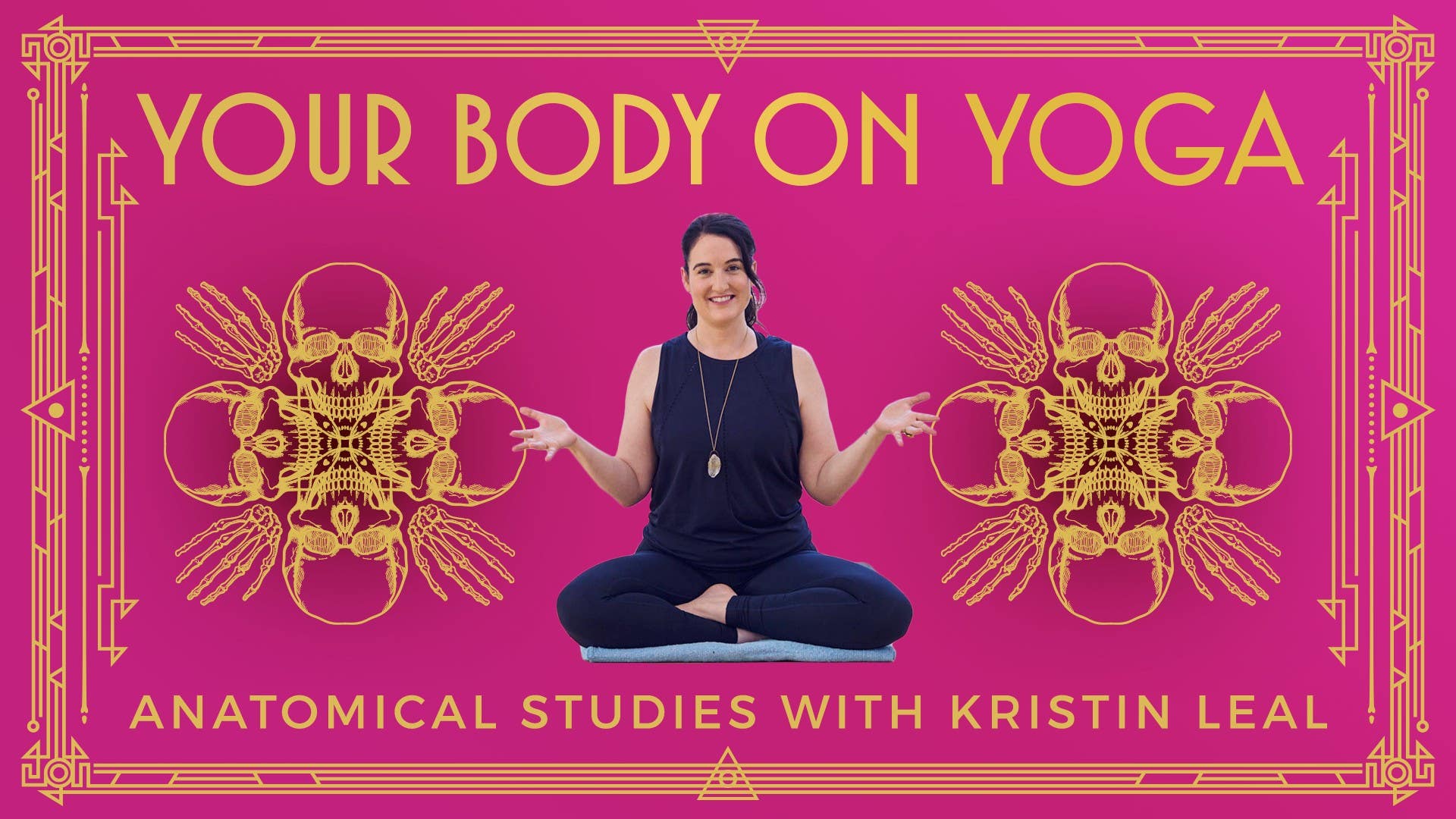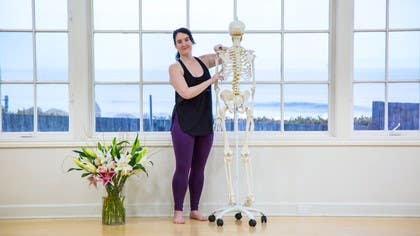Description
About This Video
Transcript
Read Full Transcript
So, I'm very grateful to have Linda Baffa with us today. You might know her from 30-Minute Flows, Flow Sweet Flow, and the soon-to-be-released upcoming show, 45-Minute Flows, so thank you so much for being here. We're really used to seeing bones and skeletons and movement on our plastic skeletal friends like Eduardo, but it's worth taking a look on a real beautiful three-dimensional form. So I'm going to have Linda turn around for a moment, and let's observe her fantastic shoulder blades or scapula. Well done.
Parents, well done. So we can see the angles of her scapula, right, looking almost like a downward-pointing triangle. We have our medial border of the scapula, our inferior angle of the scapula, our superior angle of the scapula, and then we can kind of see on her this rise of the spine of the scapula all the way around to her chromium process on top of her shoulder, almost like where you'd put a handbag. Now our scapula can do all sorts of really funky movement, because if you remember, the scapula doesn't have a bony connection to the thorax, to the rib cage, but rather some muscly glue. So I'm going to place this on top of her just so we can take a look at some of the cool movements it can do.
So she can shrug her shoulders up by her ears. The scapula elevate, maybe it's called elevation, then she could draw her shoulders just simply down her back, and that's called depression, not depression, but they just depress down the back. So let's just do it one more time. They can elevate and they can depress. See how much movement they have?
They can also do this kind of forward and back movement. They can move forward, almost like you're trying to make cleavage, and that's called protraction. These two shoulder blades move away from one another, all the way over almost to the sides of her body. Then they can move back almost like if they're going to crush a walnut in between her shoulder blades. They can retract all the way towards the spine itself.
Just do it one more time. They can protract, they're really moving and grooving, and then they can retract all the way back, and then just come back to neutral, and let's talk a little bit about what neutral is. I'm going to have you turn to the side. I think a lot of times as good yogis and good yoga teachers, we sometimes create yoga monsters, and we're fond of saying things like, open the chest, reach the shoulders down the back, draw the heart wide, and we're creating this false neutral of the arms behind you. It's just as possibly injurious to move from a place like that as to move from a place of the typical poor posture of when we're sinking and rounding.
A true neutral, the shoulder blades are not parallel to the wall back behind you, but they're resting a little bit forward at an angle. The socket, the glenoid fossa, the socket of the scapula is facing more at, I'm not good with degrees, but a forward angle, rather than 180 degrees out to the sides. Does that feel okay? It should feel more comfortable, it should feel more easy, you should be able to smile a little bit more than that more military, super yogi pose. I'm going to have you spin again to face the back of the room here, perfect, and then let's do a little dance.
Let's look at two more movements that the scapula can do. I'm going to ask her to start to take her arm out into abduction, and she's going to go in slow motion. As she starts to take her arm up, look what starts to happen to the scapula. That's the sound of a happy scapula. They upwardly rotate.
Look at where the socket is, the socket is facing the ceiling or the fingertips. Then she's going to lower her arm out to the side and back, and the scapula is going to downwardly rotate. We'll do it one more time. They're going to upwardly rotate, and they can downwardly rotate. They have a lot of movement, and what this is called is the glenohumeral movement.
I'm going to show you with the humerus, how the humerus and the scapula do this kind of Fred Astaire, Ginger Rogers kind of dance partnership in a healthy, intelligent shoulder. I'm going to have her do it again, and you can watch with the humerus attached here. We're going to slowly try to organize this, and then we're going to slowly move the arm out to the side, and yep, that. Then we're going to slowly move the arm back down, so you see it, right? Show them your beautiful face.
All right, so what this means is that when the arms are lifted overhead, when you take the arms overhead, the scapula must upwardly rotate. We're very fond as teachers and as yoga practitioners to draw the shoulders down the back. We even sometimes get that cue from our teachers. When our arms are lifted above our head, draw the shoulders down. That is what's called a dysfunctional glenohumeral rhythm.
When you do that, all of a sudden you have no more stability, right? This is much more stable, and it makes a difference when you're just standing and you don't have weight on your arms. This will kind of bring a little bit more fluidity and intelligence into the movement, but becomes 100 times more meaningful when you actually have the audacity now to put weight on your hands and arms. It allows this freedom, this mobility, and this stability. Your homework is to find a four-legged friend, a furry friend, and give them a little front hunch massage.
You'll notice that their socket is facing the earth. It's facing down instead of facing out to the sides like ours are. If we can mimic our four-legged friends, if we can mimic this intelligent glenohumeral rhythm, we have more stability, more freedom, more ease, and more intelligence. Thank you.
Your Body on Yoga: Upper Appendage
Comments
In case of 1 arm lifting up overhead, sometimes when a student actually upwardly rotates and elevates the shoulder blade too much as well, maybe because of the bad posture or stressed emotions causing shoulders crunched for a long time). In the case, could the shoulder blade still points out (in upward rotation) and depressed, relatively away from the ear?
You need to be a subscriber to post a comment.
Please Log In or Create an Account to start your free trial.










